|
|
 Dr.
He Qi is a Doctor of Aesthetics and consultant to the
Amity Christian Art Centre in Nanjing, Jiangsu Province.
He is a member of the Chinese Artists' Association and an
executive board member of the Asian Christian Art
Association. He has been teaching classes in Christian Art
at the Nanjing Union Theological Seminary since 1983. The
ANS editor Ian Groves spoke with Dr. He about his
background and his thoughts on the nature of Chinese
Christian art at the current time. Dr.
He Qi is a Doctor of Aesthetics and consultant to the
Amity Christian Art Centre in Nanjing, Jiangsu Province.
He is a member of the Chinese Artists' Association and an
executive board member of the Asian Christian Art
Association. He has been teaching classes in Christian Art
at the Nanjing Union Theological Seminary since 1983. The
ANS editor Ian Groves spoke with Dr. He about his
background and his thoughts on the nature of Chinese
Christian art at the current time.
**********
How did you become a
Christian?
During the Cultural Revolution, while I was a Middle
School student, I was sent down to the countryside to do
manual labour in the early 1970s. This was something which
happened to most Middle School Students at that time. I
didn't want to do heavy physical labour every day, so I
found a way to get out of this. At that time there was a
huge demand for portraits of Chairman Mao, since everyone
wanted to hang his portrait in their home or workplace.
So, I managed to spend my days painting, copying portraits
of Chairman Mao, instead of labouring in the fields.
One day I happened to come across a very old copy of a
magazine which contained a picture of the painting
"Madonna and Child" by Raphael. I was extremely
moved by this painting. At the time of the Cultural
Revolution the atmosphere was one of struggle, of hatred,
of criticism. All around you could only see images of
struggle and criticism. It was hard to find any images of
peace. So, you can imagine how I felt when I saw this
picture, with the Madonna smiling and the little baby
Jesus also smiling out at me. I was deeply moved and
touched, and felt a great sense of peace. After this, I
did portraits of Chairman Mao by day and then, late at
night, I did some copies of the "Madonna and
Child," both sketches and oil paintings. I gave some
of these copies to friends to encourage them too. To this
day I still keep one of those oil paintings and recently a
famous woman writer who was my neighbour during those
times told me that she still has one of the "Madonna
and Child" sketches which I gave her.
Does "Chinese
Christian Art" have to be produced by a Chinese
person who is a believer, in your view? Can a non-Chinese
or a non-believer produce "Chinese Christian
Art"?
I think we have to be very open-minded on this point.
Christianity has not played as big a role in Chinese
history as it has in the West, and we do not have the same
Christian cultural background as the West. If we find some
painters who are not Christian but who are interested in
producing works of art with Christian themes or motifs
then we naturally welcome and encourage them to do this.
Through their work with Christian art, some Chinese
artists can come to approach and even accept the Christian
faith, such as myself and some of my fellow-artists.
It doesn't depend so much on the background of the
painter, whether he or she is of Chinese origin or whether
he or she is a believer, so much as which style and
technique is used. When Western missionaries spent a long
time in China in the past and learned a lot about Chinese
art techniques and then applied these to the creation of
Christian art with Chinese characteristics, I think we can
still call this "Chinese Christian art".
People are very busy these days, making money and doing
other things. Therefore, it is very important to develop
Chinese Christian art, as a work of visual art can convey
a powerful and complex message very quickly and
effectively to busy people. We need to produce Christian
art in a Chinese indigenous way so that people will know
the Gospel message also belongs to Chinese people, and not
just to foreigners.
Many church buildings in
China are built according to Western models, and inside
these churches believers sing translations of Western
hymns and hang classical Western Christian paintings on
their walls. How do Chinese believers view Christian works
of art with Chinese characteristics? Are Chinese believers
open to your work and the work of other Chinese Christian
artists?
This is a hard question to answer.
Recently some pastors visited me and wanted me to
produce some works of art for their churches. I was happy
to do this. But, when they asked me to do some copies of
classical works by Leonardo DaVinci, then I refused. I
wanted to do some of my own works with Chinese
characteristics and showed them some examples. When they
saw Jesus with a Chinese face they became nervous and
feared their congregations would not accept such an image.
The older pastors in the church today were strongly
influenced by Western missionaries in China before
Liberation. After the Second World War, particularly in
the 1950s and 60s, other parts of the world managed to
distance themselves from Western influences in
Christianity and developed their own understandings and
expressions of the faith, such as with Liberation Theology
in South America and with indigenous expressions of
Christian faith in Africa. Even in Asia, we now have the
Asian Christian Art Association, which looks at producing
Christian art in an indigenous Asian way. But, in China,
after 1949, we closed the door to the world, so these
trends passed us by and we didn't know what was happening
in the church outside of China. So, when the church
reopened in China in the 1980s, many pastors and
congregations still clung to old traditional Western
expressions of faith, including seeing classical
Renaissance artwork as the only valid expression of the
Christian faith within art. It is difficult to change this
kind of idea in older pastors. The problem is not with the
church leadership, since people such as Bishop K.H.Ting
and Dr. Wenzao Han have traveled a lot and seen a lot, so
they know what has been happening in the outside world and
they have a more open mind.
Older pastors at this time still have a
strong psychological attachment to the ways and traditions
instilled in them by Western missionaries. It is very
difficult to change this. Therefore, it could be that we
will not see a shift in attitude toward Chinese indigenous
Christian art until the next generation, the next century.
Since this is the case, I see my teaching among the students
at the Nanjing Union Theological Seminary as very important,
as the students I teach will become the future pastors of
the next generation. Our work is not so much for the present
time but more a preparation for the future.
<extract
from http://www.asianchristianart.org>
¡@
|
Some
of He Qi's Artworks
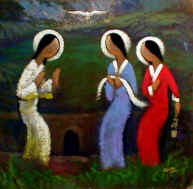
Easter Morning
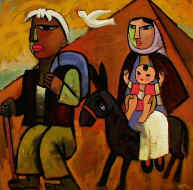
Escape to
Egypt
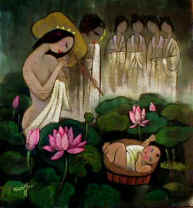
Finding of
Moses
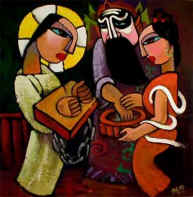
Pilate Washing
His Hands
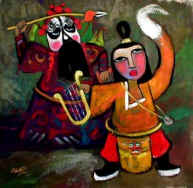
Saul and David
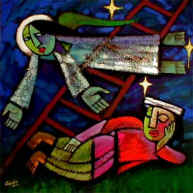
The Dream of
Jacob
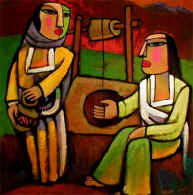
The Samaritan
Women
¡@
¡@
|